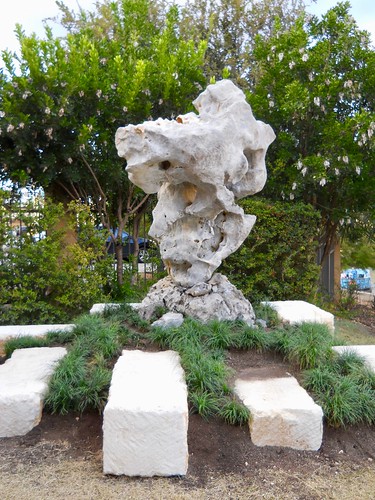Texans like to say that “everything is big in Texas.” But the latest six-and-a-half-ton acquisition by the San Antonio Museum of Art gives credence to the familiar saying.
The city of Wuxi, China, gave the city a 12-foot Taihu rock to help promote Chinese art and culture in the Alamo city. The massive rock was installed in the pavilion behind the museum prior to the recent unveiling.

The Taihu rock
The Taihu rock is from Lake Taihu in Jiangsu province. Wuxi, a city with more than six million people, is in Jiangsu province. Wuxi is one of San Antonio’s 11 sister cities. San Antonio’s Tricentennial last year brought Wuxi officials to the city. That visit led to an agreement between the two entities to bring a Taihu rock.
Last week’s unveiling and dedication ceremony brought together San Antonio Mayor Ron Nirenberg, Consul General of the People’s Republic of China in Houston, Cai Wei, Xiao Wei, Deputy Chairman of the Wuxi Museum, and several other dignitaries.


Curator Shawn Yuan, Director Katie Luber, Curator Emily Sano, Board Member Rosario Laird
The dedication ceremony also included a preview of “Elegant Pursuits: The Arts of China’s Educated Elite, 1400-1900.” It opened in conjunction with the dedication of the Taihu Rock. The exhibit, on loan from the Wuxi Museum, will be on display through Feb. 23, 2020.
The exhibition is made up of 26 works of art, including paintings, ceramics, calligraphy, jade carvings, gold, and silver objects. Several artworks are by master artists, and many have never traveled abroad.

Xu Wenxiong (1868–?), Summer Gathering, 1930, Ink and color on paper, 21” x 13”, Wuxi Museum, China (A-663)
Taihu rocks were revered by the Chinese elite for their aesthetic value. They have been sculptural elements in Chinese garden design for a thousand years. The exhibit highlights China’s lifelong love of these spectacular rocks.
“This type of rock is considered an embodiment of the yin-yang dichotomy and represents harmony between man and nature. Some of the best are quarried near Wuxi on the shores of Lake Taihu,” said SAMA’s Assistant Curator of Asian Art, Shawn Yuan.

Taihu rock yard
SAMA is one of only a handful of museums in the United States to house and display the venerable Taihu rock. The artistic and cultural collaboration began when Wuxi’s vice mayor, Liu Xia, visited SAMA during the city’s Tricentennial in 2018.

The Taihu rock
Katie Luber, SAMA director, suggested to Xia that having a Taihu rock would promote China’s culture and art when Xia said she was impressed by the museum’s Chinese art collection. Xia and Luber joined forces, the culmination of which is the towering Taihu rock and the new Chinese art exhibition.

Wine Cup and Plate in the Shape of Peonies, Yuan dynasty, 13th c., Silver, 2.5” x 7.1”, Wuxi Museum, China (J4-20)
At the recent unveiling, Luber laughed when she recalled that it was Yuan who whispered in her ear to ask Liu Xia for a Taihu rock. Luber, who’s been director for the past eight years, admitted that until that day she knew very little about the exquisite rock.

San Antonio city officials, museum and Wuxi officials all agreed the natural rock art would be a great way to introduce San Antonio residents to more Chinese art and culture, since SAMA already has an extensive Asian Arts collection.

Jiang Rong (1919–2008), Teapot, 20th c., Clay, 7.2” x 4.5” x 4”, Wuxi Museum, China, (H2-34)
The logistic challenge of lifting the 12-foot rock from its Wuxi home and transporting it from China to Houston-and finally San Antonio-required the herculean support and help of local engineers, architects, and even dentists.
A SAMA official said lifting the rock and placing it in the pavilion was like “having a dental implant,” which is why dentists were consulted about placing the mammoth rock atop a pedestal facing the San Antonio River Walk. The pedestal was erected by the local architectural firm of Overland Partners.
Meanwhile, Elegant Pursuits seemed like the perfect complement. The exhibition features limestone artworks extraordinarily shaped over thousands of years by the ebb and flow of natural water. Holes in many of the rock art pieces inspire observers to form their own conclusions about man and nature.
Elegant Pursuits exhibition and the Taihu rock presentation were made possible through the generous support of the Wuxi Museum and the Municipal People’s Government of the city of Wuxi, China.

Song Maojin (?–after 1620) Winding Brook in “Fifty Views of Jichang Garden" Ming dynasty, early 17th c. Album leaf, ink and colors on silk 13” x 11” Wuxi Museum, China
Local businesses, organizations, and individuals included A1 Engineering, E Rhodes and Lenora B. Carpenter Foundation, Ruth Chang, Henry Cornell, Thomas Edson, Guido Construction, Victor Lam, Rose Marie and John Hendry, Overland Partners, and Barbara and George Williams
The SAMA was officially founded in 1970 and is housed in the former Lone Star Brewery complex. For more information call (210) 978-8100. Or visit: www.samuseum.org
Rosie Carbo is the Lifestyles Editor for Wandering Educators, and is a former newspaper reporter whose work has appeared in newspapers and magazines nationwide. Some of those publications include People magazine, The Dallas Morning News, The Houston Chronicle, and San Antonio Express-News. Some of her features were redistributed by The Associated Press early in her career as an award-winning Texas journalist.
